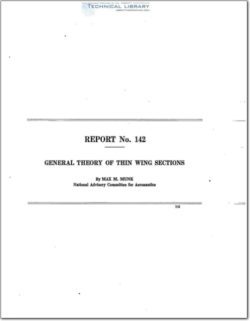naca-report-142

- Version
- 184 Downloads
- 900.21 KB File Size
- 1 File Count
- April 19, 2016 Create Date
- April 19, 2016 Last Updated
National Advisory Committee for Aeronautics, Report - General Theory of Thin Wing Sections

By changing the angle between the stabilizer and the elevator the wing section formed
by the combination of stabilizer and elevator is altered, and this alteration gives rise to new
aerodynamical forces. It is useful to discuss this phenomenon from the theoretical point of
View, however imperfect the result may be as a consequence __of neglecting the viscosity of the
air. A theoretical investigation at least gives the limit of what to expect. It enables the
investigator to survey and keep in mind a great number. of isolated experiences, whether the
agreement between theory and experience be more or less close. It induces him to reflect on
the phenomenon and thus becomes a source of progress by guiding him to new observations
and experiments. It has often occurred even that some relation was thought to be confirmed
by experience till the progress of theory made the relation improbable. And only then the
experiments confirmed the improved relation, contrary to what they were supposed to do
before. A. very conspicuous example of this is the discovery of differences 1n the atomic weight
of certain elements. .But is it really necessary to plead for the usefulness of theoreticalwork'l
This is nothing but systematical thinking and is not useless as sometimes supposed, but the
difficulty of theoretical investigation makes many people dislike it.
In this first section I wish to give a short summary of the theory which I am going later
to apply and to expand. This theory deals with the relation between the shape of a wing
section and the air forces applied to it by a. nonviscous fluid. Only the two-dimensional prob-
lem is considered. The theory thus forms the completion of the theory of the induced drag,
in which latter the three-dimensional arrangement of the wings and the lift produced by them
alone is considered, without paying attention to the details ofproducing the lift. The value
of the induced drag and the effective angle of attack of every part of the wings result from
the calculation. The theory of the wing section, however, gives no drag at all, for the drag
additional to the induced drag 1s due to viscosity.
| File | Action |
|---|---|
| naca-report-142 General Theory of Thin Wing Sections.pdf | Download |
Comment On This Post